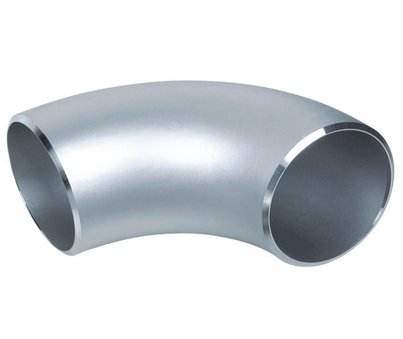An Simple Introduction to Stamping Elbows (Part Two)
Posted: 08/30/2017 01:18:59 Hits: 16
Advantages of large stamping elbows' forming processes are mainly manifested in the following aspects.
⑴ Stamping elbows don't need tube blanks as raw materials, which can not only save money in pipe making equipment and molds, but also obtain any pushing elbow with the large diameter and the relatively thin wall. The raw material of this kind of stamping elbow is special and it is easy to control the material in the manufacturing process of the stamping elbow.
⑵ Tube blanks of stamping elbows are flat plates; therefore, stamping processes are simple; stamping processes can ensure good accuracy of stamping elbows and can make tamping elbows easy to be assembled and welded.
⑶ Manufacturing cycles of stamping elbows are shortened due to the two reasons above, which can greatly reduce production costs of stamping elbows. No special equipment is required for manufacturing the stamping elbow; therefore, the stamping process is especially suitable for processing the large stamping elbow on site.
Materials
Stamping elbows' materials include carbon steel, stainless steel and alloy steel. Carbon steel stamping elbows are cheap and have wide applications, while alloy steel elbows are used in special locations.
Stainless steel elbows' materials make stainless steel elbows differ from carbon steel elbows, and chemical composition of the materials will keep surfaces of stainless steel elbows from rust and corrosion.
Stainless steel features in non-rust and corrosion resistance; chromium content of stainless steel is at least 10.5%; the maximum carbon content of stainless steel is less than 1.2%. The matrix of the austenite stainless steel is mainly in the austenite structure (the γ phase); the austenite stainless steel is nonmagnetic and is strengthened by cold working which may generate certain magnetism.
Austenite- ferrite two-phase stainless steel
Austenite-ferrite two-phase stainless steel whose matrixes are austenite and ferrite two-phase structures is magnetic and can be strengthened by cold working.
Ferrite stainless steel whose matrixes are mainly in the ferrite structures ( α phases ) is magnetic; ferrite stainless steel can not be hardened by heat treatments, but cold working can make ferrite stainless steel slightly strengthened.
Matrixes of martensite stainless steel are in the martensite structures; martensite stainless steel is magnetic and its mechanical properties can be adjusted by heat treatments.
Precipitation-hardening stainless steel
Stainless steel whose matrixes are in the austenite or martensite structures can be hardened or strengthened by the precipitation-hardening treatment.
⑴ Stamping elbows don't need tube blanks as raw materials, which can not only save money in pipe making equipment and molds, but also obtain any pushing elbow with the large diameter and the relatively thin wall. The raw material of this kind of stamping elbow is special and it is easy to control the material in the manufacturing process of the stamping elbow.
⑵ Tube blanks of stamping elbows are flat plates; therefore, stamping processes are simple; stamping processes can ensure good accuracy of stamping elbows and can make tamping elbows easy to be assembled and welded.
⑶ Manufacturing cycles of stamping elbows are shortened due to the two reasons above, which can greatly reduce production costs of stamping elbows. No special equipment is required for manufacturing the stamping elbow; therefore, the stamping process is especially suitable for processing the large stamping elbow on site.
Materials
Stamping elbows' materials include carbon steel, stainless steel and alloy steel. Carbon steel stamping elbows are cheap and have wide applications, while alloy steel elbows are used in special locations.
Stainless steel elbows' materials make stainless steel elbows differ from carbon steel elbows, and chemical composition of the materials will keep surfaces of stainless steel elbows from rust and corrosion.
Stainless steel features in non-rust and corrosion resistance; chromium content of stainless steel is at least 10.5%; the maximum carbon content of stainless steel is less than 1.2%. The matrix of the austenite stainless steel is mainly in the austenite structure (the γ phase); the austenite stainless steel is nonmagnetic and is strengthened by cold working which may generate certain magnetism.
Austenite- ferrite two-phase stainless steel
Austenite-ferrite two-phase stainless steel whose matrixes are austenite and ferrite two-phase structures is magnetic and can be strengthened by cold working.
Ferrite stainless steel whose matrixes are mainly in the ferrite structures ( α phases ) is magnetic; ferrite stainless steel can not be hardened by heat treatments, but cold working can make ferrite stainless steel slightly strengthened.
Matrixes of martensite stainless steel are in the martensite structures; martensite stainless steel is magnetic and its mechanical properties can be adjusted by heat treatments.
Precipitation-hardening stainless steel
Stainless steel whose matrixes are in the austenite or martensite structures can be hardened or strengthened by the precipitation-hardening treatment.

Post URL: https://www.landeepipefitting.com/an-simple-introduction-to-stamping-elbows-part-two.html
Landee is a professional industrial pipe fitting manufacturer and be well accepted by customers all over the world, we has been producing Pipe Fitting for a variety of applications since 1985. welcome to access our website: https://www.landeepipefitting.com.
Previous: An Simple Introduction to Stamping Elbows (Part One)
Next: Applications of Eight Different Gaskets (Part One)
Next: Applications of Eight Different Gaskets (Part One)
